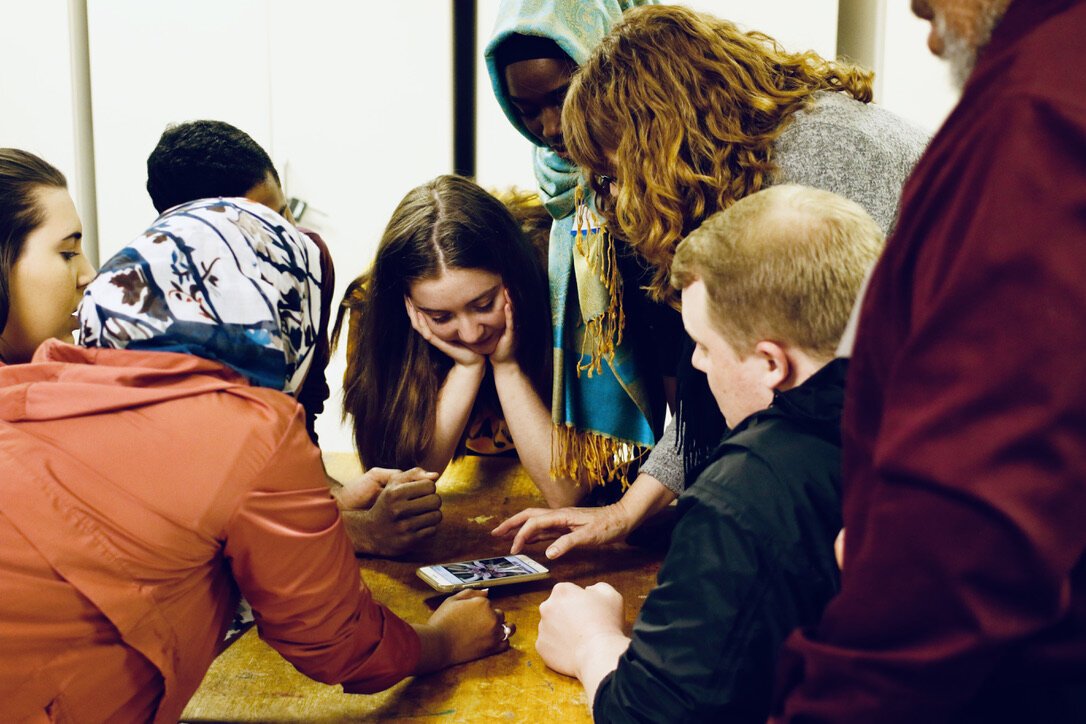Sharing that Cultivates Love
Participating in an Interfaith Photovoice project was a real gift to me. I was delighted by people’s openness and willingness to share and the encouragement for everyone to share. Most group or social settings evoke some kind of anxiety for every person. The extrovert is anxious to meet as many people as possible, to make friends, and to be noticed. The introvert is nervous of making a social faux pas or coming off weird and unacceptable to strangers. Interfaith Photovoice obviously is more formal than most social gatherings, but it was a different experience for me than even those more formal small gatherings that we do in religious settings, clubs, or organizations. Every voice was heard because every voice is supposed to be heard.
Photo 1. The small group listens as this participant shares her story.
Interfaith Photovoice structures conversation by giving healthy parameters around difficult conversations through the use of photography. By people taking their own photos in answer to a given question and bringing them for group sharing and dialogue, people have ownership of the story they tell, and everyone brings a story to tell. Every single person participating in the project gets to be in the spotlight. I found how sharing in this way gave dignity and honor to every person in the group, which made us all feel safe to share more honestly and openly. Those afraid of making social faux pas are given general guidelines for everyone to follow to ease their anxiety; those afraid of missing out on a friend get to listen to everyone share.
It gets even better. After each person shares, there is an open floor for anyone from the small group to comment on that person’s photo. Not only did I get to share my own photos, why I composed them the way I did, and what they mean to me from my perspective, I also was given the gift of everyone else’s insight. It was truly meaningful.
There were a number of ideas other people noted about my own photos that I had not thought about yet. It was such a gift to hear people’s comments because they made me think deeper and wider about what I shared. One photo I shared was of a tree statue wearing a worried, stupefied face with a monkey hanging on one of the limbs. I took this photo in response to the question, “What challenges do you face in your community because of your beliefs, practices, and values?” The challenge I was trying to represent was fear and misunderstanding or lack of understanding. One woman pointed out the way the monkey on the tree limb looked at the worried tree with compassion and kindness, whereas I saw the monkey more as a corrective, wise guide. It gave me a new perspective on the same situation and made me reflect on why I immediately thought of a more corrective sage-type character rather than a healing compassionate hand.
Photo 2. “It is when we do not know and do not want to know that we become like this tree, scared frozen. When we choose to not know and learn the needs of others, we actually isolate ourselves from knowing and befriending those around us, and the needs of others are not met properly. Lack of understanding creates division, distrust, and enmity between groups and people. Even in our fear, maybe there is a monkey sitting on our shoulder, putting his hand on our head, giving us the compassion and courage to understand. Understanding others takes effort and sacrifice, but I believe it is worth it because it fosters love, compassion, and unity” (Jessica). Jessica wrote these reflections once the project was finished including the new perspective a fellow participant offered.
In addition, a number of people made comments to me in response to some of my more vulnerable sharing which encouraged me greatly. One person just affirmed the difficulty of the experience I had shared. This person actually paused while she responded to me, and even that silence with another human being looking at me trying to find the words to respond to what I shared was a healing moment for me, even though I had never known this person before. While she looked at me for that moment I could see her trying to process my experience, lingering on my words, her eyes looking at me ever so slightly. I could feel that what I said impacted her and wondered if part of her understood my experience in her own way. Another person acknowledged sharing similar feelings to me. I felt not only seen and validated but also encouraged and empowered to do something in response to my difficult situation.
Photo 3. Everyone carefully “gazes” upon this photo in the middle after a participant shared its meaning.
And all of this happened with people that do not all believe exactly what I believe as a Christian, and that part has stuck with me the most. Because of the way that we shared with each other, there was such a vulnerability and space for love to be cultivated. I felt a level of safety to be honest, of being known and loved that I do not always even experience in my own religious spaces. I believe this is because we “gazed” upon one another, stopping to be truly present. And the photos aided our ability to gaze. Before we came to our photovoice meeting, we practiced this gazing as we were forced to stop, reflect, and capture photographs representing our stories. As we all shared, there was time to truly see and be seen, and this created space for love to be born and grown.



